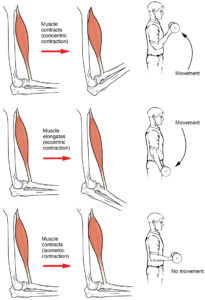 How Do Muscles Contract?
How Do Muscles Contract?
Contraction is an interesting choice of words when it comes to talking about muscles. Technically a contraction should shorten a muscle but we label a number of different actions contractions though only one fits the literal definition. I love anatomy.
The smooth and cardiac muscles that I wrote about in the last post contract and work without conscious control but our skeletal muscles that work voluntarily have a number of contractile options. There are two main types of muscle contraction— isometric and isotonic. In an isometric contraction the length of the muscle doesn’t change when engaged. In an isotonic contraction there is a change in the length of a muscle as it works against an outside force.
There are two types of isotonic contractions—concentric and eccentric. In a concentric contraction a muscle shortens as it contracts such as showing off your biceps. In an eccentric contraction the muscle lengthens as it contracts.
So many poses we do involve isometric contraction but I typically talk about isometric contraction when I teach the hands in tree pose. When push the hands against each other as hard as possible while attempting to pull them apart at the same time, this brings a feeling of awakening and tone to all of the muscles of the arms and shoulders.
I love squatting and I often teach a wide legged squat using both eccentric and concentric contractions of the levator ani muscle of the pelvic floor. This a pretty standard prenatal yoga exercise that I have co-opted. The idea is to engage and tone you levator ani in two different ways in the same exercise.
When the body lowers to a squat and you maintain tone in the pelvic floor you are creating an eccentric contraction as you stretch the muscle. And if you keep that same tone as you lift up you are working a concentric contraction as the muscle shortens.
***

